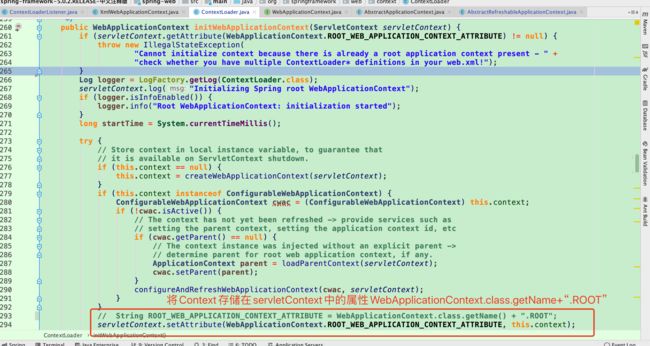深入浅出Spring的IOC容器,对Spring的IOC容器源码进行深入理解
文章目录
- 1.关于web.xml加载问题
-
- 1.1.ServletContext 初始化
- 1.2.ContextLoaderListener.contextInitialized(ServletContextEvent)
- 1.3.ContextLoader.initWebApplicationContext
- 1.4.servlet的初始化
- 1.5.WebApplicationContext的主要实现类
-
- 1.5.1.XmlWebApplicationContext
- 1.5.2.AnnotationConfigWebApplicationContext
- 1.6.总结
- 2.DispatcherServlet
-
- 2.1.整体继承图
- 2.2.入口:DispatcherServlet.init()
- 2.3.HttpServletBean.init()
- 2.4.FrameworkServlet.initServletBean()
1.关于web.xml加载问题
1.1.ServletContext 初始化
1.Tomcat在进行启动的时候,会将context-param等相关参数全部初始化到ServletContext对象上
2.同时,会通知listener-class对应的类ContextLoaderListener(当然,也可以进行自定义)
web.xml 配置样例
<context-param>
<param-name>name</param-name>
<param-value>gaoxinfu</param-value>
</context-param>
<listener>
<listener-class>org.springframework.web.context.ContextLoaderListener</listener-class>
</listener>
1.2.ContextLoaderListener.contextInitialized(ServletContextEvent)
1.3.ContextLoader.initWebApplicationContext
/**
* Initialize Spring's web application context for the given servlet context,
* using the application context provided at construction time, or creating a new one
* according to the "{@link #CONTEXT_CLASS_PARAM contextClass}" and
* "{@link #CONFIG_LOCATION_PARAM contextConfigLocation}" context-params.
* @param servletContext current servlet context
* @return the new WebApplicationContext
* @see #ContextLoader(WebApplicationContext)
* @see #CONTEXT_CLASS_PARAM
* @see #CONFIG_LOCATION_PARAM
*/
public WebApplicationContext initWebApplicationContext(ServletContext servletContext) {
if (servletContext.getAttribute(WebApplicationContext.ROOT_WEB_APPLICATION_CONTEXT_ATTRIBUTE) != null) {
throw new IllegalStateException(
"Cannot initialize context because there is already a root application context present - " +
"check whether you have multiple ContextLoader* definitions in your web.xml!");
}
Log logger = LogFactory.getLog(ContextLoader.class);
servletContext.log("Initializing Spring root WebApplicationContext");
if (logger.isInfoEnabled()) {
logger.info("Root WebApplicationContext: initialization started");
}
long startTime = System.currentTimeMillis();
try {
// Store context in local instance variable, to guarantee that
// it is available on ServletContext shutdown.
if (this.context == null) {
this.context = createWebApplicationContext(servletContext);
}
if (this.context instanceof ConfigurableWebApplicationContext) {
ConfigurableWebApplicationContext cwac = (ConfigurableWebApplicationContext) this.context;
if (!cwac.isActive()) {
// The context has not yet been refreshed -> provide services such as
// setting the parent context, setting the application context id, etc
if (cwac.getParent() == null) {
// The context instance was injected without an explicit parent ->
// determine parent for root web application context, if any.
ApplicationContext parent = loadParentContext(servletContext);
cwac.setParent(parent);
}
configureAndRefreshWebApplicationContext(cwac, servletContext);
}
}
servletContext.setAttribute(WebApplicationContext.ROOT_WEB_APPLICATION_CONTEXT_ATTRIBUTE, this.context);
ClassLoader ccl = Thread.currentThread().getContextClassLoader();
if (ccl == ContextLoader.class.getClassLoader()) {
currentContext = this.context;
}
else if (ccl != null) {
currentContextPerThread.put(ccl, this.context);
}
if (logger.isDebugEnabled()) {
logger.debug("Published root WebApplicationContext as ServletContext attribute with name [" +
WebApplicationContext.ROOT_WEB_APPLICATION_CONTEXT_ATTRIBUTE + "]");
}
if (logger.isInfoEnabled()) {
long elapsedTime = System.currentTimeMillis() - startTime;
logger.info("Root WebApplicationContext: initialization completed in " + elapsedTime + " ms");
}
return this.context;
}
catch (RuntimeException ex) {
logger.error("Context initialization failed", ex);
servletContext.setAttribute(WebApplicationContext.ROOT_WEB_APPLICATION_CONTEXT_ATTRIBUTE, ex);
throw ex;
}
catch (Error err) {
logger.error("Context initialization failed", err);
servletContext.setAttribute(WebApplicationContext.ROOT_WEB_APPLICATION_CONTEXT_ATTRIBUTE, err);
throw err;
}
}
最终实现了下面的赋值

这里进行XMLWebApplicationContext的存储

1.4.servlet的初始化
上面listener的初始化parent context初始化完成之后,会进行初始化各个web.xml文件中的servlet
如下:servlet :DispatcherServlet的初始化,DispatcherServlet的初始化见下面章节
<?xml version="1.0" encoding="UTF-8"?>
<web-app xmlns:xsi="http://www.w3.org/2001/XMLSchema-instance"
xmlns="http://java.sun.com/xml/ns/j2ee" xmlns:javaee="http://java.sun.com/xml/ns/javaee"
xmlns:web="http://java.sun.com/xml/ns/javaee/web-app_2_5.xsd"
xsi:schemaLocation="http://java.sun.com/xml/ns/j2ee http://java.sun.com/xml/ns/j2ee/web-app_2_4.xsd"
version="2.4">
<display-name>Gupao Web Application</display-name>
<context-param>
<param-name>name</param-name>
<param-value>gaoxinfu</param-value>
</context-param>
<listener>
<listener-class>org.springframework.web.context.ContextLoaderListener</listener-class>
</listener>
<servlet>
<servlet-name>myservlet</servlet-name>
<servlet-class>org.springframework.web.servlet.DispatcherServlet</servlet-class>
<init-param>
<param-name>contextConfigLocation</param-name>
<param-value>application.properties</param-value>
</init-param>
<load-on-startup>1</load-on-startup>
</servlet>
<servlet-mapping>
<servlet-name>myservlet</servlet-name>
<url-pattern>/*
1.5.WebApplicationContext的主要实现类
1.5.1.XmlWebApplicationContext
1.采用xml配置,则Spring将使用XmlWebApplicationContext启动Spring容器,即通过XML文件为Spring容器提供Bean的配置信息;
配置样例
<context-param>
<param-name>contextConfigLocation</param-name>
<param-value>classpath:/config/applicationContext.xml</param-value>
</context-param>
<listener>
<listener-class>org.springframework.web.context.ContextLoaderListener</listener-class>
</listener>
1.5.2.AnnotationConfigWebApplicationContext
如果使用@Configure的java类提供配置信息,则需要在xml中进行相关配置,
设置contextClass参数值为AnnotationConfigWebApplicationContext类,contextConfigLocation参数值则为使用了@Configure注解的类。
使用案例
@Configuration
@ServletComponentScan
@ImportResource(locations = {
"classpath:/config/applicationContext.xml" })
@SpringBootApplication
public class ThirdApplication {
public static void main(String[] args) {
System.setProperty("org.apache.cxf.stax.allowInsecureParser","1");
SpringApplication.run(ThirdApplication.class, args);
}
1.6.总结
1.这里大家可以认为父parent context:WebApplicationContext的初始化;
首先大家,去看Spring的源码入口,第一个就是DispatcherServlet
2.DispatcherServlet
2.1.整体继承图
2.2.入口:DispatcherServlet.init()
可以看到入口在HttpServletBean.init()中
2.3.HttpServletBean.init()
@Override
public final void init() throws ServletException {
if (logger.isDebugEnabled()) {
logger.debug("Initializing servlet '" + getServletName() + "'");
}
// Set bean properties from init parameters.
PropertyValues pvs = new ServletConfigPropertyValues(getServletConfig(), this.requiredProperties);
if (!pvs.isEmpty()) {
try {
//定位资源
BeanWrapper bw = PropertyAccessorFactory.forBeanPropertyAccess(this);
//加载配置信息
ResourceLoader resourceLoader = new ServletContextResourceLoader(getServletContext());
bw.registerCustomEditor(Resource.class, new ResourceEditor(resourceLoader, getEnvironment()));
initBeanWrapper(bw);
bw.setPropertyValues(pvs, true);
}
catch (BeansException ex) {
if (logger.isErrorEnabled()) {
logger.error("Failed to set bean properties on servlet '" + getServletName() + "'", ex);
}
throw ex;
}
}
// Let subclasses do whatever initialization they like.
initServletBean();
if (logger.isDebugEnabled()) {
logger.debug("Servlet '" + getServletName() + "' configured successfully");
}
}



